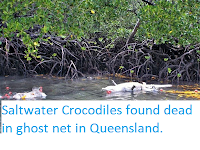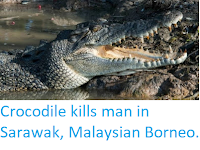The conservation organisation Fauna & Flora International has reported a clutch of Siamese Crocodile, Crocodylus siamensis, hatchlings being observed in the Veal Veng Crocodile Sanctuary on the Stung Knong River in Pursat Province, Cambodia, only the second time the species has been seen breeding in the wild in Cambodia in a decade. Ten hatchlings have been observed at the site, a large clutch for the species, which is classed as Critically Endangered under the terms of the International Union for the Conservation of Nature's Red List of Threatened Species.
A hatchling Siamese Crocodiles, Crocodylus siamensis, in the Veal Veng Crocodile Sanctuary in Cambodia this year. Southeast Asia Globe.
Once found across Southeast Asia, Borneo, Java and Sumatra, the species is now thought to be extinct in Malaysia, Singapore, and Brunei, with about 250 adult Crocodiles in the wild in Cambodia, about 100 in Vietnam, and an unknown number in Laos. There are also small surviving populations in East Kalimantan (Indonesian Borneo), and possibly Thailand and Java. There are also successful captive-breeding programs in several places, which gives some hope for the survival of the species, though as the greatest threat to the wild populations is considered to be habitat loss, it is unclear if it will ever be possible to release captive-bred Siamese Crocodiles into the wild.
A captive-bred Siamese Crocodile at the Phnom Tamao Wildlife Rescue Centre in Cambodia. Southeast Asia Globe.
Siamese Crocodiles are not considered a threat to Humans, reaching a maximum size of about 4 m and feeding largely on Frogs, small Snakes, and similar prey. There are only four confirmed attacks on Humans by the species, all non-fatal, and in two of these cases the animal was defending itself, while in third it was defending its young. A fatal attack on a child by a Siamese Crocodile in Thailand in 1928 may have been made by a Siamese Crocodile, but this is uncertain. Siamese Crocodiles have historically been hunted extensively, both for their skins and for captive breeding in farms (again for their skins), but today the largest threat to their survival in the wild is considered to be habitat loss, largely to deforestation which changes the nature of the environment around the rivers the species inhabits. The Siamese Crocodiles are also still threatened by poaching.
See also...
Follow Sciency Thoughts on Facebook.








